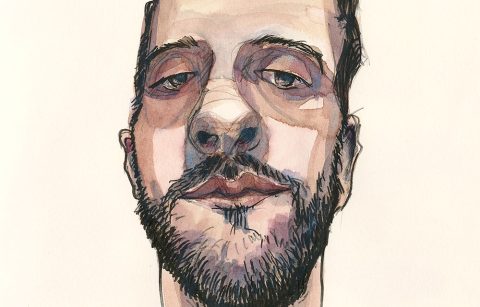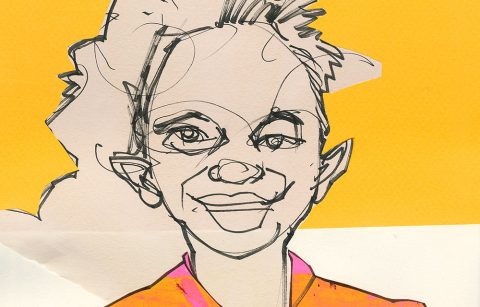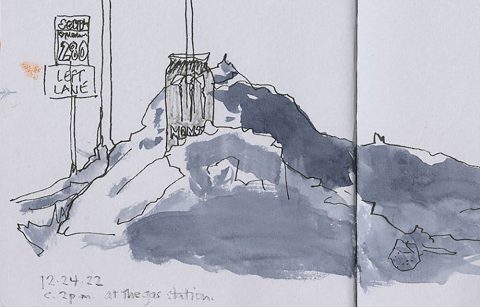On March 10, 2010 I wrote a post on Polymer Clay Color Inspirations—Techniques and Jewelry Projects for Creating Successful Palettes, by Lindly Haunani and Maggie Maggio. (Watson-Guptill, 2009)
A reader, Cheryl, wrote in and asked if I could recommend a book on color theory using watercolor as the basic medium. I believe Haunani and Maggio did such an excellent job their book deserves to be looked at by artists working in all media. However, since starting the blog in October 2008 I have published a number of posts on color theory and related topics and have mentioned several books that discuss color theory from the painter’s perspective. Cheryl’s question gave me a nudge to mention my favorite books on color theory in one post, this page.
Following the list of books, which starts with my two favorite and then lists books in no particular order, I also provide links to a number of posts on my blog relating to color theory. (I didn’t set up a category for this, sigh! Clicking on “Paints” in the category list will get you to them, but you have to scroll by non-color theory related posts.) The posts I provided links to show swatches I’ve made when testing new colors, discuss how I’m making choices, and also discuss the properties of the paints I’m testing. You might find them interesting if you are curious as to how to run your own tests or are curious about my choices.
I teach color theory and if you would like to participate in a class in the Twin Cities you can check the “Classes” category on this blog or go to my website and check class listings there. If you would like to organize a class you can contact me at [email protected].
I would like to make one more point before I get to my list: use your paints. Buying swatch books and staring at swatches is not going to bring you an epiphany concerning mixing watercolors (or whatever media you work in). Getting your paints out and mixing them together on the paper you are actually going to paint on, with the brushes you are actually going to use is the only way you can actually really absorb color theory and begin to make it work for you in your artwork.
OK, a couple more points. When you read a book on color theory and stare at those swatches you have to remember that you are looking at a printed approximation. CMYK (cyan, magenta, yellow and black) inks have been used to create the image you are looking at—arranged in a dot pattern not a continuous smear of paint. (And if you are looking at swatches on the internet—well that’s RGB (red, green, blue), and it still isn’t the real paint.
So do some reading, but then put down the books, pick up your brush, and move some paint around.
Note: Most watercolor (or any paint how-to book) will contain an introductory chapter on selecting a palette, explaining color theory, and so on. Some authors/artists are excellent at taking those brief discussions and making them so clear with the examples of their work and their approach that a lot of color theory learning can be accomplished quickly. I have listed a couple of those books in the following list.
When you start thinking about color theory it will help if you identify paintings and artists that you admire. If those artists (as Quiller has in my case) have written books about their painting method and approach to color, I recommend you start with those books. You already have an affinity for the artist and her/his approach—that will make absorption of the concepts easier.
Color theory is FUN. If you don’t think so then you haven’t had the right teacher. Sure there is science and rules and laws of light and all you want to do is move paint around—but if you first understand these concepts the moving around of paint will be infinitely more pleasurable to you. (And also in many ways more challenging as you try to push the envelop of what you want to accomplish with color as an artist. The upside of the learning is that you will then have the understanding to push yourself and your art.)
When you read any of these books, I recommend that you read a couple chapters, set the book aside for a week or so and think about what you’ve read. Think about what you read when you look at art in the hall of your office building or on a trip to the art institute. Then go back after a week and reread those chapters, doing any and all exercises recommended. Continue, as you have time in the next couple of weeks, to work your way through the book in the order the book was presented. (Authors and editors take great pains to organize the material in a useful fashion for learning so resist the urge to jump around.) Also resist the urge, if you become frustrated, to put the book aside for several weeks and return to it later. You may find your initial learning has evaporated. Build on it instead, by continuing to work a little bit with these authors every day, or every few days. Your knowledge will grow and if you stick to it with regular practice you will be constantly rewarded with “aha” moments. Those moments will increase your learning enjoyment and your learning momentum.
Facility with mixing colors is something we all build on every day we work. Try to work every day, even if for only 15 minutes. You are toning and exercising a muscle. If you don’t use that muscle regularly it won’t be there for you when you need it.
Again, I can’t stress this enough, the study of color theory is fun. It’s an adventure.
To Whet Your Appetite
Victoria Finlay, Color: A Natural History of the Palette
This isn’t a how-to book or a theory book. Finlay has written a history of man’s appropriation and manufacture of pigments—and what results. Fascinating and well-written. Starting with this book might be just the approach you need to see color as a living and vibrant part of art and man’s effort to communicate.
Books on Color Theory I Recommend
Stephen Quiller, Color Choices
Quiller discusses his color wheel; walks you through monochromatic, complementary, analogous, split complement, and triadic color schemes with examples from his own work (which is stunning and clearly puts the principles he writes about into visual form). The book is filled with useful and direct exercises which will help you hone your skills in any watermedia you work with: watercolor, gouache, cassein, or acrylics. He continues with a discussion of his working methods, on-location painting, and paint application techniques for watermedia. He ends with a discussion of the works of several famous master colorists like Vermeer and Turner. This book is not replaced by the following book of his. Both are essential.
Stephen Quiller, Painter’s Guide to Color
In this later book Quiller takes a look at his revised color wheel, his color palette selections and focuses on making neutrals (also discussed in the previous book, but really a topic of focus in this one). He looks at value, intensity, harmony, near grays, and color families. There are numerous exercises suggested throughout the book to help the reader better grasp the concepts. He wraps up with more on his painting methods and ends with a look at a different bunch of master colorists. It is NOT simply a rehash of his earlier book. Both are essential.
Jeanne Dobie, Making Color Sing!
Dobie has a wonderful loose but realistic approach to her rendering. She also paints in the glazing tradition (washes of color are built up in the watercolors as glazes). This is an excellent book for both its approach to color theory (and the avoidance of mud which plagues new painters) and its discussion of painting technique. If you are looking for both in one book, this is a great place to start.
Christopher Schenk, Mastering Color and Design in Watercolor
Like Dobie’s book, Schenk’s is a wholistic approach to watercolor and color theory. I highly recommend this book which is particularly strong on its discussion of design and compositional components to make stronger paintings.
Nita Leland, Exploring Color (1998 is my copy—I think she has a newer version)
Leland leads the reader through the language of color with examples from other artists’ work as well as her own. She breaks down the study of color into manageable bits with lots of charts as well as exercises on making your own charts to fully understand her concepts. Leland also provides charts of several palettes you might want to experiment with—standard, opaque, intense, old masters, earth—all based on triads of specific reds, blues, and yellows. She also deals with the vocabulary and concepts of color theory: monochromatic, complementary, near complementary, harmony, and contrast. All her discussions include examples, exercises.
Michael Wilcox, The Wilcox Guide to the Best Watercolor Paints
Wilcox is known for his “School of Color” and the many books he has produced (several of which are on this list). I am fond of this book, though I own an old edition (1991). Wilcox presents a history of each color family and then provides a graduated swatch sample of the paint with that name from each manufacturer of artist quality paint. He includes information on lightfastness, idiosyncratic behavior (such as bronzing in some blue paints), and working properties. This is an excellent place to start when comparing between brands. Sadly Daniel Smith watercolors were not included in this edition. The material can be used for research, and compared with other sources (such as the Handprint website) to make decisions on currently available paints and pigments. He also includes sections on color mixing. I found this an essential book when learning about pigments.
John Lidzey, Collins Watercolour Workshops (1995)
John Lidzey is one of my favorite artists. He drew with deliciously textured and nuanced pencil lines and employed a limited palette with neutralized and muted mixes successfully creating moody environments. In this book he provides an excellent, simple introduction of color theory and the use of a limited palette with practice exercises. There are loads of examples of his charming work. He also provides numerous step-by-step demonstrations.
Charles Reid, Various books listed below:
Reid has a very idiosyncratic approach to color in his paintings. Well actually we all do, but his is most obviously so—with his blobs of unblended colors and strokes of wash outside his pencil lines. I love his work and think it is visually pleasing. I makes me smile. But it isn’t how I work and how I use color. Still I believe I learned a lot about color and technique from reading his books. The Natural Way To Paint focuses on nudes; Painting Flowers in Watercolor focuses on floral still-life painting; Watercolor Solutions covers a variety of techniques he uses throughout his paintings. All three of these books have a very similar introduction to his approach to color theory, his selection of his color palette, and his techniques of brush handling. Even if you have no intention of working in his footsteps you can learn much from his books (which are exceedingly easy to read—very engaging). Watercolor Solutions has a companion CD that a friend lent me. I strongly recommend that you watch the lessons on the disk if you are interested in his working method.
Arthur Guptill, Color in Sketching and Rendering (1935)
This book is out of print and I was able to track an earlier edition down through a used bookseller. If you are interested in this particular book I suggest you do the same as later manifestations have been edited down to leave out some really interesting tidbits. Other portions have been repurposed in later books from Watson-Guptill. This book, in its earlier form is a wonderful grandfather of a how-to-book with great diagrams and discussions. You can follow through on these exercises and gain knowledge and skill; in fact, many of the books on sale today are made on this model.
Michael Wilcox, Blue and Yellow Don’t Make Green
A detailed discussion of the science of color—not for everyone, but I find it a good read with lots of diagrams.
Michael Wilcox, Colour Mixing Swatch Book
As I have said earlier I don’t care for swatch books much, but I have several because I take them to classes to show the students and to discuss the good points of each. Wilcox’s version is usefully organized and a good point of departure for experimentation.
Michael Wilcox, Perfect Color Choices for the Artist
I found this book interesting but at times confusing. This is definitely not your first color theory book. However I find it a fun book to look at the examples of master paintings which are then broken down for the reader into color schemes and mixes. I worry about what the author used as his “original” image as some reproductions of master paintings are sadly faded and altered as to their original color. Add to this the issue of looking at things through the CMYK ink reproduction and there is another layer of possible difficulty. But if you already understand color theory you will enjoy a romp through this book.
John Lidzey, Jill Mirza, Nick Harris, and Jeremy Galton, Color Mixing for Artists
This is a step up from the swatch book genre. Each artist takes a medium with Lidzey dealing with the watercolors. Images are examined with an eye to how the colors it contains were mixed, i.e., what proportion of red (and which red) was mixed with what proportion of yellow (and which yellow) to achieve this orange. A dangerous book to simply look at. Remember to get your paints out and try to achieve these mixes.
John Lidzey, Walter Foster Artist Library Series: Mix Your Own Watercolors
This is essentially the same material of Lidzey’s on watercolor as was contained in Color Mixing for Artists, except there is new material and some omissions. I love having both books because it means additional examples of this recently deceased artist—he died in April 2009.
Moira Clinch, The Watercolor Painter’s Pocket Palette
Families of colors mixed in grids of swatches with interspersed discussion of a painting which uses the color under discussion. This book is everywhere and most students in my color theory classes have a copy of it. It is fine as a swatch book and I add it to the list because of that, but don’t use this or any swatch book as a crutch. Explore your paints, mix your own colors!
Note: I have additional favorites I’m puzzled to not find on my shelves. I’ll add to the list as they turn up.
Website for Watercolor Color Theory and Pigment Information
Handprint is a wonderful resource of information about watercolor paint by Bruce MacEvoy. He not only discusses paints at this site (brands, lightfastness, manufacture) but he also writes about color theory. Spend some time looking around at the various topics he discusses.
Roz Wound Up Posts on Color Theory and Selecting Watercolor and Gouache Palettes
If you’re looking for travel palettes, you can view my palettes for watercolor and gouache at Travel Palettes for Watercolor and Gouache.
In Project 640 Tubes: Selecting a Gouache Palette I recommend Stephen Quiller’s books as well as books by Jeanne Dobie and Nita Leland. (I also write about my color palette choices for gouache in that post so if that interests you you’ll want to read the full post.)
Fun of the Best Kind: Work—Choosing a Palette Here I write about choosing a palette and comparing the same color/pigment from different brands.
My Schmincke Pan Watercolor Palette and More on Schmincke Pan Watercolors discuss how I worked through and picked some colors for this particular palette. I show color swatches of the various mixes that I worked through. If you want to make your own color swatch charts this post, which talks about mixing the paint on the paper, might be of interest.
Irodori Antique Watercolor from Holbein provides swatches of a triad and discusses the properties of this paint.
Trying Out Some Watercolors from Daniel Smith looks at Rhodonite Genuine, Transparent Red Oxide, and Serpentine Genuine, with swatches showing the mixes I’m testing.
Another Way to Approach Terra Rosa from M. Graham looks at the color swatches generated by testing M. Graham’s Terra Rosa in a triad with Indanthrone Blue and Indian Yellow.
New Daniel Smith Watercolors looks at the enviro-friendly Oxides Daniel Smith released early in 2009, along with a couple additional colors for blending possibilities.
More Watercolor Tests looks at a couple M. Graham and Daniel Smith Watercolors.
If you go to my website Rozworks.com in the Leisure Reading section, you’ll find an article I wrote about adding and deleting pigments from my watercolor palette. If you haven’t worked through the building of a palette before the questions I ask myself as I make my mixes and weed paints out may proove useful. For example: no lovely Undersea Green from Daniel Smith because it uses the pigments in Quin Gold and French Ultramarine blue (a good reason to read Michael Wilcox’s paint book or other such sources). The Quin Gold is on my travel palette, and while FUB isn’t, Indanthrone blue mixes well with Quin Gold to yield a dazzling “undersea green,” freeing up a space on the palette.
Note: I’m going to add a “Color Theory” category to my blog, but earlier posts will have to be looked for here on this page or through “paint.”





















